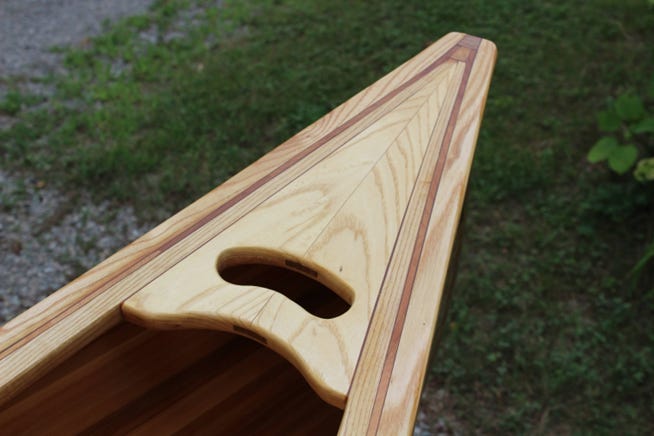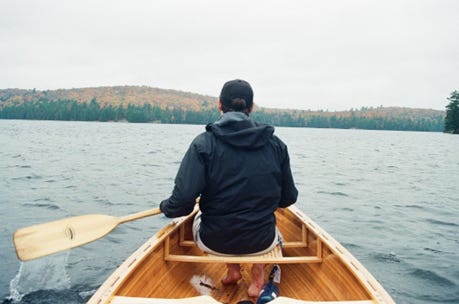This Canoe was Born
From the archives - the story of Eila and Steve's cedar strip canoe build (part 1)
Steve and I have been fixing the cedar strip canoe that we built in 2021. It got wrecked two years ago on May 21st, 2022, when the derecho caught us out camping on Big Gull Lake in Frontenac county.
I came across this old letter from January 17th, 2022, before we had any idea what was in store for us.
For now, enjoy this little trip down memory lane - this post will be followed by the story of the storm.
Eila and Steve’s Wild Goose Chaser
About this time last year [January 2021], Steve and I saw a video of Xyla Foxlin building a cedar strip canoe on Youtube. It caught my interest, and out of curiosity, I checked the Ottawa public library to see what books, if any, they had on building canoes. I checked out a half dozen books that seemed vaguely relevant and brought them home for my perusal – “just for fun”, I told myself.
One of those books, “Canoecraft”, by Ted Moores, had all the information and instructions one could ever need to build a canoe. I read the whole thing. And the next thing you know, we were cleaning out the garage at the family cottage and dusting off Steve’s grandfather’s tools. Armed with a well-laid plan and the naive optimism only a pair of amateurs could have, we had decided to build our own canoe.
It was a natural progression, see. The previous summer we’d taken a 10-day canoe trip down the Spanish River, travelling over 160km through the Northern Ontario back-country. What with weekend trips to Algonquin and various other paddling destinations, the canoe rental fees were starting to add up. “How wonderful would it be,” we said, “to have a canoe of our own. And while we’re at it, let’s build the thing ourselves!”
There were a few major milestones when we realized we were fully committed to building our canoe. The first was building the strong-back, the table upon which the canoe forms are mounted. The other was buying the cedar out of which the canoe would be built. We built the strong-back in one weekend. “Ho-ho,” cried we, “building this canoe is going to be a breeze!” We also bought the wood that was to become our canoe – ten planks of 16’ long 1x6 select cedar boards.
We set about by first tackling the milling of the wood. The planks we bought needed to be ripped down into ¼” thick strips, so that they would be bendy enough to fit around the canoe forms. Each strip also needed to be routed along its length – one edge in a “bead”, and the other in a “cove”, so that they will fit together nicely around the curves of the hull.
Another thing we had to do was bend the wood for the canoe stems before we installed the forms. The stems are formed of three ¼” thick strips of wood, steamed and bent into shape before being laminated together. The inner stem is pine, because of its light weight and ease of shaping. The outer stem is ash – selected because it is a hardwood that will stand up to some abuse, but still bends well.
With the wood milled, the forms cut and installed on the strong-back, and the stems shaped and in place, construction of the canoe could begin. We decided to build the canoe using various jigs to clamp the wood in place while the glue set, rather than stapling the strips to the canoe forms. Each piece would be glued, clamped in place, and left to set for a couple hours. This meant that we could only do 3-4 strips a day.
As the days passed, the canoe began to take shape. To close the bottom, the strips were cut back to the centre line. From then on, each strip was hand-planed to an angle that fit exactly into the hull.
After completing the hull, we installed the outer stems with epoxy, and sanded the entire exterior of the boat until it was completely smooth. Then, a 6oz. fibreglass cloth was laid over the canoe and we wet it out with epoxy. We did 4 coats of epoxy, spaced about 2 hours apart. The fibreglass was then left to cure. This is what gives the boat much of its strength! It also ensures it doesn’t leak.
Then, we flipped the boat off the forms, and sanded and fibre-glassed the inside too.
The hull of the boat was complete. Next, was the finishing touches. Steve made many jigs for building the canoe trim. He framed up the seats, built the canoe decks, and shaped the yoke. Eila wove the cane for the seats. We cut scuppers into the inner gunnels, and after varnishing everything, the final assembly of the canoe could be completed.
Finally, we had everything in place! We couldn’t wait to take it out on the water – the only thing holding us back was the final coat of varnish. In a perfectionist’s world, the varnish would have been painstakingly applied, one coat a day for a week, until a perfect mirror finish was achieved. But at this point, we’d been building the thing for a whole summer, and there were only a few paddling weekends left in the season! So, after two coats, away we took it on some adventures.
The finished boat is a thing of beauty (if I do say so myself). The first time we scraped a rock we were quite distraught. But she’s held up great so far, and we are much looking forward to the places we will take it this upcoming season.
Her unofficial name is “Wild Goose Chaser”, after the iconic Canadian birds that we shall be paddling after.
I end this letter with a selection of beauty shots!
-Eila






















